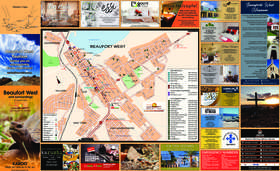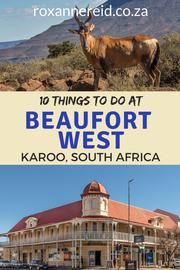A Walk Around Town
Beaufort West is a typical "platteland" town with a rich, romantic history.
Fine examples of the town’s early architecture can be seen on a comfortable walk through its historic centre. These cover a mixture of flamboyant Victorian, elegant Georgian, serene Edwardian, Eclectic, Romanesque, Cape Dutch, Neo-Gothic, Neo-Classic and Contemporary styles. Examples of typical Karoo cottages still survive. Some of these buildings, the old Town Hall, the old Mission Church and the Barnard House, all now part of the museum, as well as Matoppo House and Clyde House, are national monuments.
The handsome Neo-Gothic Dutch Reformed Mother Church, built in 1892, is a landmark on the busy N1 route. In the eleventh Dutch Reformed parish in South Africa, the congregation built a small thatched roofed building (1830), but soon membership grew and there was need for the beautiful church seen today on what was once fondly known as "Amen Corner". The church was designed by Scottish architect James Bisset and its snow white spire is a focal point of town. In its gardens are two beautiful sandstone memorials complete with fleches and embellished with crockets, in memory of two of its early ministers. Also in its grounds is a memorial to General the Rev Paul Roux, who was a Boer soldier during the Anglo Boer War.
Christ Church Anglican Church, built in 1850 in a heavy Romanesque style, was designed by Sophie Gray, who modelled all her designs on the country churches of England. She was the wife of Robert Gray, first Bishop of Cape Town. Among her designs, this one is unique, local tradesmen departed from her plans and built the church taller and wider.
There is an exceptionally handsome church in the Contemporary style in Rustdene, on the south side of town. Striking use is made of rugged natural materials which, in combination with the physical shape of the building, create a unique atmosphere. Features of this church, built entirely by the community, are simultaneously functional and symbolic in concept.
The town’s main street is hardly ordinary, behind its name lies the tenderest of love stories. The main street was named in honour of Sir Rufane Donkin, who acted as Governor from 1820 to 1821. Sir Rufane, a true romantic, lost his wife while they were stationed in India. So devastated was he that he had his beloved Elizabeth’s heart embalmed and took it with him everywhere. When Sir Rufane died, Elizabeth’s heart was buried with him in England.
At the north end of Donkin Street is the local jail, built in 1873, a building of considerable presence, executed in the heavy Neo-Classic manner of the mid-Victorian period. Nobody seems to know why it was built in the main street. Its first jailer, an African-American, was also jailed there for negligence on duty - but he escaped, never to be seen again.
A restored blockhouse, built in 1901 during the Anglo-Boer War, still guards the railway bridge on the road south. Graves of Boer and British soldiers can be seen in the old cemeteries of Beaufort West, Nelspoort and Merweville.
Heart-transplant pioneer Professor Chris Barnard, the town’s most famous son, is honoured in the museum. The recently reopened exhibition shows a display of awards presented to him and a replica of the original heart transplant theatre as well as historical pictures of Beaufort West.







